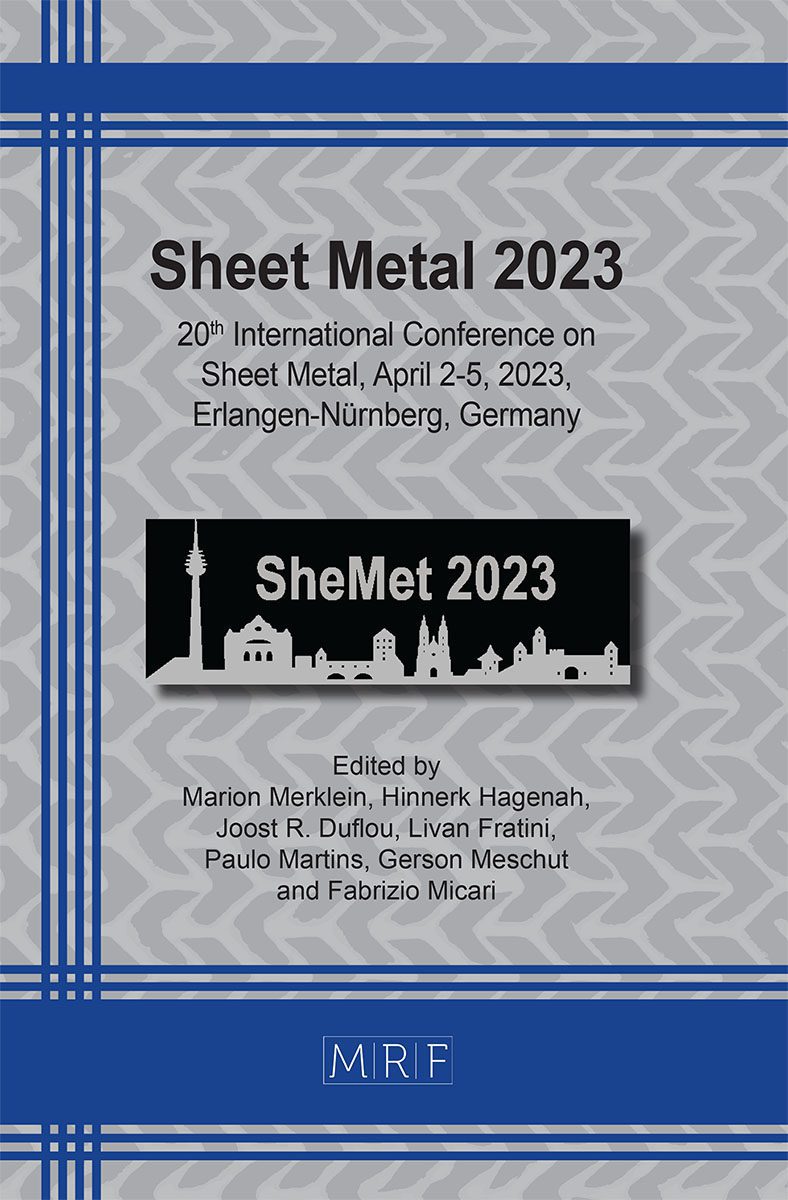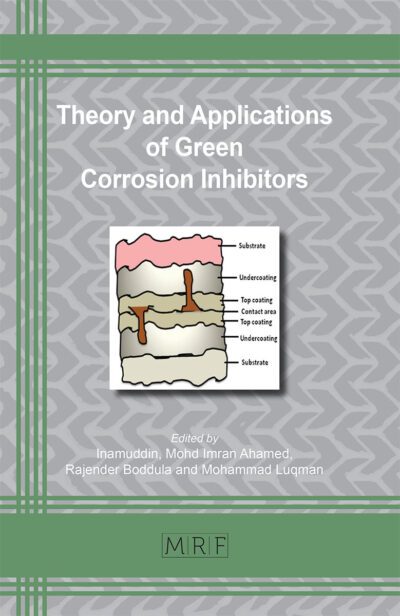Numerical and experimental investigations of piercing fibre-reinforced thermoplastics
Benjamin Gröger, Jingjing Wang, René Füßel, Juliane Troschitz, Daniel Köhler, Christian Vogel, Andreas Hornig, Robert Kupfer, Maik Gude
download PDFAbstract. The joining of continuous fibre-reinforced thermoplastic composites (TPC) by means of plastic deformation often results in a complex material structure in the forming zone. Especially process- and material-related parameters have high influence on the local deformation behaviour and therefore on the properties of the joint. In this paper, the focus is on mechanical joining processes based on the principle of moulding holes by a tapered pin. For the investigations, a simplified test is used in which the pin is pushed through a heated TPC plate in the thickness direction. By the pin movement the fibres and molten matrix are displaced radially and along the tool motion direction. Detailed investigations of the resultant material structure by computed tomography and numerical simulations are performed with varying pin tool geometries with bidirectional TPC material. For numerical analysis, the Arbitrary-Lagrangian-Eulerian method combined with a multi-filament approach is used. The result show that the tool geometry has a strong influence on the piercing force, the resultant material structure, and the occurring phenomena. It could be shown, that the simulation is capable to predict the resultant material structure.
Keywords
Joining, Simulation, Fluid-Structure Interaction
Published online 3/17/2023, 8 pages
Copyright © 2023 by the author(s)
Published under license by Materials Research Forum LLC., Millersville PA, USA
Citation: Benjamin Gröger, Jingjing Wang, René Füßel, Juliane Troschitz, Daniel Köhler, Christian Vogel, Andreas Hornig, Robert Kupfer, Maik Gude, Numerical and experimental investigations of piercing fibre-reinforced thermoplastics, Materials Research Proceedings, Vol. 25, pp 171-178, 2023
DOI: https://doi.org/10.21741/9781644902417-22
The article was published as article 22 of the book Sheet Metal 2023
![]() Content from this work may be used under the terms of the Creative Commons Attribution 3.0 licence. Any further distribution of this work must maintain attribution to the author(s) and the title of the work, journal citation and DOI.
Content from this work may be used under the terms of the Creative Commons Attribution 3.0 licence. Any further distribution of this work must maintain attribution to the author(s) and the title of the work, journal citation and DOI.
References
[1] Galińska A, Galiński C. Mechanical Joining of Fibre Reinforced Polymer Composites to Metals-A Review. Part II: Riveting, Clinching, Non-Adhesive Form-Locked Joints, Pin and Loop Joining. Polymers (Basel) 2020;12(8). Https://doi.org/10.3390/polym12081681
[2] Lambiase F, Scipioni SI, Lee C-J, Ko D-C, Liu F. A State-of-the-Art Review on Advanced Joining Processes for Metal-Composite and Metal-Polymer Hybrid Structures. Materials (Basel) 2021;14(8). Https://doi.org/10.3390/ma14081890
[3] Gröger B, Troschitz J, Vorderbrüggen J, Vogel C, Kupfer R, Meschut G et al. Clinching of Thermoplastic Composites and Metals-A Comparison of Three Novel Joining Technologies. Materials (Basel) 2021;14(9). Https://doi.org/10.3390/ma14092286
[4] Troschitz J, Füßel R, Kupfer R, Gude M. Damage Analysis of Thermoplastic Composites with Embedded Metal Inserts Using In Situ Computed Tomography. J. Compos. Sci. 2022;6(10):287. https://doi.org/10.3390/jcs6100287
[5] Seidlitz H, Gerstenberger C, Osiecki T, Simon S, Kroll L. High-performance lightweight structures with Fiber Reinforced Thermoplastics and Structured Metal Thin Sheets. JMSR 2014;4(1). Https://doi.org/10.5539/jmsr.v4n1p28
[6] Hirsch F, Müller S, Machens M, Staschko R, Fuchs N, Kästner M. Simulation of self-piercing rivetting processes in fibre reinforced polymers: Material modelling and parameter identification. Journal of Materials Processing Technology 2017; 241(1):164–77. https://doi.org/10.1016/j.jmatprotec.2016.10.010
[7] Troschitz J, Gröger B, Würfel V, Kupfer R, Gude M. Joining Processes for Fibre-Reinforced Thermoplastics: Phenomena and Characterisation. Materials (Basel) 2022;15(15). Https://doi.org/10.3390/ma15155454
[8] Brown NWA, Worrall CM, Ogin SL, Smith PA. Investigation into the mechanical properties of thermoplastic composites containing holes machined by a thermally-assisted piercing (TAP) process. Advanced Manufacturing: Polymer & Composites Science 2015;1(4):199–209. https://doi.org/10.1080/20550340.2015.1117748
[9] Popp J, Kleffel T, Römisch D, Papke T, Merklein M, Drummer D. Fiber Orientation Mechanism of Continuous Fiber Reinforced Thermoplastics Hybrid Parts Joined with Metallic Pins. Appl Compos Mater 2021;28(4):951–72. https://doi.org/10.1007/s10443-021-09892-0.
[10] Kraus M, Frey P, Kleffel T, Drummer D, Merklein M. Mechanical joining without auxiliary element by cold formed pins for multi-material-systems. In: Proceedings of the 22nd international Esaform conference on material forming: Esaform 2019. AIP Publishing; 2019, p. 50006.
[11] Amancio-Filho ST, Blaga L-A (eds.). Joining of Polymer-Metal Hybrid Structures. Hoboken, NJ: John Wiley & Sons, Inc; 2018.
[12] Feistauer EE, Amancio-Filho ST. Ultrasonic Joining of Lightweight Alloy/Fiber-Reinforced Polymer Hybrid Structures. In: Amancio-Filho ST, Blaga L-A, editors. Joining of Polymer-Metal Hybrid Structures. Hoboken, NJ: John Wiley & Sons, Inc; 2018, p. 307–333.
[13] Gröger B, Hornig A, Hoog A, Gude M. Modelling of thermally supported clinching of fibre-reinforced thermoplastics: Approaches on mesoscale considering large deformations and fibre failure. ESAFORM 2021. https://doi.org/10.25518/esaform21.4293
[14] Roth S, Pracisnore F, Coutandin S, Fleischer J. A new approach for modelling the fibre path in bolted joints of continuous fibre reinforced composites. Composite Structures 2020;243(2):112184. https://doi.org/10.1016/j.compstruct.2020.112184
[15] Donea J, Huerta A, Ponthot J-P, Rodriguez-Ferran A. Arbitrary Lagrangian-Eulerian Methods. In: Stein E, Borst René de, Hughes TJR, editors. Encyclopedia of Computational Mechanics. Chichester, UK: John Wiley & Sons, Ltd; 2004, p. 657.
[16] Green SD, Long AC, El Said BSF, Hallett SR. Numerical modelling of 3D woven preform deformations. Com. Struct. 2014; 108:747–56. https://doi.org/10.1016/j.compstruct.2013.10.015.
[17] Wang Y, Sun X. Digital-element simulation of textile processes. Composites Science and Technology 2001;61(2):311–9. https://doi.org/10.1016/S0266-3538(00)00223-2
[18] Gröger B, Würfel V, Hornig A, Gude M. Forming process induced material structure of fibre-reinforced thermoplastics – Experimental and numerical investigation of a bladder-assisted moulding process. Journal of Advanced Joining Processes 2022;5(7):100100. https://doi.org/10.1016/j.jajp.2022.100100
































